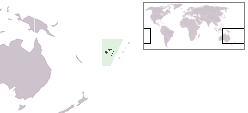Lakeba

Map of Fiji
|
|
| Geography | |
|---|---|
| Location | Fiji |
| Coordinates | 18°13′S 178°47′W / 18.217°S 178.783°WCoordinates: 18°13′S 178°47′W / 18.217°S 178.783°W |
| Archipelago | Lau Islands |
| Adjacent bodies of water | Koro Sea |
| Total islands | 1 |
| Major islands | 1 |
| Area | 59.5 km2 (23.0 sq mi) |
| Length | 8.5 km (5.28 mi) |
| Administration | |
|
Fiji
|
|
| Division | Eastern |
| Province | Lau Province |
| Largest settlement | Tubou (pop. 500) |
| Demographics | |
| Population | 2100 (2014) |
| Pop. density | 35.3 /km2 (91.4 /sq mi) |
| Ethnic groups | Indo-Fijians ; other (Asian, Europeans, other Pacific Islander) |
Lakeba (pronounced [laˈkemba]) is an island in Fiji’s Southern Lau Archipelago; the provincial capital of Lau is located here. The island is the tenth largest in Fiji, with a land area of nearly 60 square kilometers. It is fertile and well watered, and encircled by a 29-kilometer road. Its closest neighbors are Aiwa and Nayau. Separated by deep sea from the latter but only by shallow waters from the former, when sea levels were lower during glacial episodes Lakeba and Aiwa formed one large island.
It has a population of around 2,100 in eight villages, the most important of which is the capital Tubou which lies in the island’s south. Near Tubou is the village of Levuka; not to be confused with its namesake – Fiji’s old capital – Levuka on Lakeba is home to a fishing tribe whose ancestors came from Bau Island. Another significant village is Nasaqalau, located in the northern part of Lakeba.
Situated at 18.20° South and 178.80° East, Lakeba has an irregular oval shape. About 9 kilometers long and 8 kilometers wide, it is circumscribed by a total shoreline of 32 kilometers. The island, which has a maximum altitude of 219 meters, has a core of andesitic volcanic rock of Miocene age, with raised coral rock around it. The limestone lies bare in places, forming karst and – particularly on the north and north-west coasts – cliffs up to 76 meters high; the overall area taken up by bare limestone is about 4% of Lakeba's total land surface. A reforestation programme has seen the planting of Lakeba's hills (formerly partially denuded by deforestation) with Caribbean pine (Pinus caribea) trees.
...
Wikipedia

